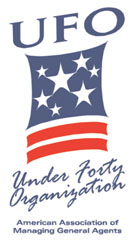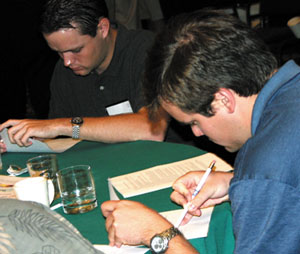MGAs play the
"company game"
Computer-assisted exercise helps young MGAs
understand what it takes
to run an insurance company
By Phil Zinkewicz
 There is a game being played today among young people in the insurance industry, and it has nothing to do with Parker Brothers. You don’t need any dice; there are no little men to move around a board; and you’re not buying or selling properties or collecting $200 when you pass “Go.”
There is a game being played today among young people in the insurance industry, and it has nothing to do with Parker Brothers. You don’t need any dice; there are no little men to move around a board; and you’re not buying or selling properties or collecting $200 when you pass “Go.”
This is a game where you start out in the morning pretending you are the CEO of a major property and casualty insurance company, spend the day underwriting coverages and making investment choices, and then, by dark, find out whether you have brought the insurance company up to the heights or driven it into bankruptcy.
This game was played last September in Napa Valley, California, by a group of young insurance executives who are members of the Under Forty Organization (UFO), a special committee of the American Association of Managing General Agents (AAMGA). UFO was formed in 1990 to give younger members of the AAMGA an opportunity to communicate with the older, more seasoned members of the association—to learn from them and to exchange views on industry matters. Recognizing that younger members of the association will be the AAMGA leaders of the future, the association decided that UFOs should have a voice in the affairs of the AAMGA, in the AAMGA University and in the industry as a whole.
|
Members of AAMGA’s Under Forty Organization (UFO) work during an educational session last fall. During this training session, UFOs played PRIME, a computer-assisted management exercise which helped them learn how insurance companies operate. |
While networking is the primary goal of UFO, many of its members also take advantage of educational opportunities that are offered to them. For example, at the invitation of Lloyd’s of London’s Worldwide Markets Division, members of UFO journey to London once a year to learn how the marketplace operates, an event of particular importance in light of the fact that the insurance industry is becoming more global. And last fall’s Napa Valley event also speaks to the UFO’s desire to have its members learn more about the industry.
At that meeting, UFO members played a game called PRIME, a computer-assisted management exercise designed to acquaint participants with the decision-making process involved in running an insurance company. In the game, participants are divided into teams, with each team representing the management of an insurance company that will make underwriting, staffing, financial and reinsurance decisions during the course of the exercise, which takes an entire business day. The teams’ collective actions will shape the competitive environment for each particular session.
Gen Re has been offering PRIME to audiences for more than 20 years. According to an executive overview, PRIME is based on a computer simulation of an insurance marketplace containing multiple insurers. Each insurer consists of a management team that controls the pricing of each line of business written by the company, commissions paid to producers, capacity offered, underwriting staffing levels, and investment and reinsurance strategies. The exercise usually encompasses four years of operations. At the beginning of the exercise, each team receives the company’s prior three years’ financial statements.
The object of the exercise is to maximize adjusted surplus at the end of the last year of operation. Adjusted surplus is defined as statutory surplus plus the profit element in the ending unearned premium reserve (i.e., commission rate times unearned premium reserve) less the tax on unrealized gains. Also, the company is expected to meet three corporate goals: 12% return on surplus, 99% combined ratio and 10% annual premium growth.
Each team’s company writes three commercial lines and two personal lines of business. Commercial property risks consist of light manufacturing, Main Street retailers, and both office and residential buildings. The losses are paid quite rapidly over the four-year period. On the commercial casualty lines, Casualty 1 has a relatively short tail with risks that include light manufacturing, mercantile, automobile, and owners, landlords and tenants. Here losses are paid over a seven-year period. On the other hand, Casualty 2 may be generally categorized as long-tail business (losses are paid over a 10-year period) including heavy manufacturing and both personal and commercial umbrellas. Personal auto is a relatively standard mix of personal automobile. Personal property consists of middle and upper class dwellings with limits of $65,000 to $250,000. Small to medium-sized farms ($250,000 to $750,000) are also included.
Each year, the management team sets capacity, risk premium and commission rates by line of business and underwriting staffing levels. Reinsurance decisions are then blended into the line of business strategy. Also, management determines the relative levels of taxable bonds, tax-exempt bonds and stocks in the investment portfolio both through the allocation of cash flow and, if desired, through a moderate restructuring of the existing portfolio by selling stock. These decisions are communicated to the computer through a standardized input sheet.
|
“As MGAs, we’re wholesalers, not insurance companies. However, now we have a better understanding of what our partners on the company side face every day.”
—Jim Kranzberg
Risk Placement Services
Scottsdale, Arizona |
At the end of each year, management will receive certain financial data to assist it in making decisions regarding a statutory income statement, statutory balance sheet, cash flow statement, income tax and underwriting results, among other things.
Coryn Thalmann of the New Jersey-based Jimcor Agency found Gen Re’s PRIME program mentally stimulating. “There were about 10 people to a team, all in some way involved in the decision-making process for a fictitious insurance company. There were many of us who had never been on the carrier side of the business. It was fascinating to see what company management goes through and to recognize the potential pitfalls. It was an exhilarating day for all of us, and I wish the session had been longer.”
Similarly, Jim Kranzberg of Risk Placement Services in Scottsdale, Arizona, found PRIME particularly useful for UFO members. “Remember, we are all under 40. Where else would we be able to become exposed to the decision making that only senior management experiences? And we’ve now had this exposure early in our careers. As MGAs, we’re wholesalers, not insurance companies. However, now we have a better understanding of what our partners on the company side face every day. The UFO is hugely grateful to Gen Re for making this program available to our level of employment.”
Asked what is next on the horizon for UFO, Kranzberg said that a number of things are being considered, but nothing that he is ready to talk about yet. “We try to be creative in the types of educational events we schedule,” he says. “Basic educational courses are important to be sure, and we all take those, but in special events we try to go beyond the norm.”
Running an insurance company for four years in a single day is certainly going beyond the norm. *
 There is a game being played today among young people in the insurance industry, and it has nothing to do with Parker Brothers. You don’t need any dice; there are no little men to move around a board; and you’re not buying or selling properties or collecting $200 when you pass “Go.”
There is a game being played today among young people in the insurance industry, and it has nothing to do with Parker Brothers. You don’t need any dice; there are no little men to move around a board; and you’re not buying or selling properties or collecting $200 when you pass “Go.” 
